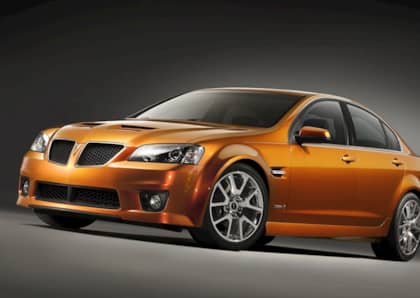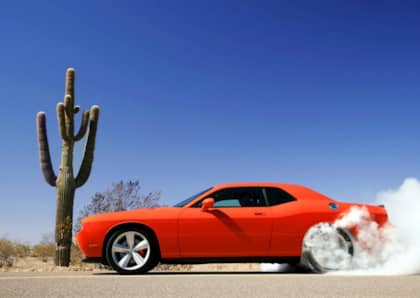5 Forgotten Concept Cars That Should Have Been Built (And What We Got Instead)
Although concept cars are often derided for being impractical flights of fancy intended to snag as many eyeballs as possible, there are times when the vehicles shown off on an auto show's main stage end up as compelling road cars a few years down the road. Vehicles like the Plymouth Prowler, the Dodge Viper and the Volkswagen New Beetle are several examples of models that made it from concept to showroom with only modest changes.
There are a number of cars we wish had been added to that list, concepts that would have made an important mark due to their timing, their technology, or the gap they would have filled for a particular automaker. For a variety of reasons they couldn't transition from the show circuit to the street, and so we're left wondering what might have been had history taken a different course.
Here's a closer look at five nearly forgotten concept cars that should have been built, along with an explanation of why they never made it—and what we got instead.
Nissan IDx
What Was It?
Introduced at the 2013 Tokyo Motor Show, the Nissan IDx was a retro-tinged, rear-wheel drive coupe that brought to mind the best aspects of the 70s-era 510, seen from a modern perspective. The car would have competed against the Subaru BRZ / Scion FR-S twins as well as the Hyundai Genesis Coupe, which had all been making waves in the sports car segment. A turbocharged, 200 horsepower 4-cylinder engine would have done the heavy lifting for the IDx.

Why Was It Never Built?
There's no question that affordable sports cars are a niche market, and that profit margins there are thin. Nissan was wary of the sales momentum that had already shifted in favor of the three cars already haunting that space, not to mention the four-cylinder versions of the Chevrolet Camaro and the Ford Mustang that were waiting in the wings. Finally, Nissan simply didn't have the production line capacity to add another rear-wheel drive model.
What Did We Get Instead?
Nissan's only concession to the tuner crowd in the last decade has been a disappointing NISMO version of the rather pedestrian Sentra sedan. Unlike past SE-R or Spec V models, the NISMO's drivetrain and suspension do little to set it apart from other small four doors, and its 188 horses are a hard sell when the Civic Type R is over 100 ponies ahead.
Cadillac Elmiraj
What Was It?
2013 was also a good year for Cadillac stylists, as they were finally set loose to produce the Elmiraj. This drop-dead gorgeous coupe featured the ultimate refinement of the brand's 'Art & Science' design language, and it turned more than a few heads at the Pebble Beach Concours d'Elegance when it was unveiled that summer. Sized to compete with the two-door Mercedes-Benz S-Class, the car's platform was large enough to be a potential flagship sedan.

Why Was It Never Built?
Although Elmiraj (and the Ciel, and the Escala) was touted as the future of the brand, and definitely feasible in terms of production, it never had any lasting influence on where the automaker ended up going. Cadillac remained locked on taking market share away from BMW and Audi at the entry level with the ATS and CTS, driver's cars that were significantly smaller than what the Elmiraj had to offer. The most fashion-forward debut from Cadillac in this era was the ELR plug-in hybrid, which was a resounding failure due to its astronomical price.
What Did We Get Instead?
Cadillac's only large car post-Elmiraj was the CT6, a vehicle that was confusingly positioned just below the BMW 7 Series and Mercedes-Benz S-Class in terms of length and mission statement. After briefly cannibalizing mid-size CTS sales, it languished on dealer lots and is slated for early termination.
Pontiac Banshee XP-883
What Was It?
The first of Pontiac's Banshee design studies in 1964, the Banshee XP-883 was intended to give the GM a true sports car player that could compete with the Ford Mustang. It offered a mix of six-cylinder and eight-cylinder drivetrains in a lightweight and relatively affordable package, and the project was spearheaded by superstar General Motors executive John DeLorean.

Why Was It Never Built?
When GM brass found out about the Banshee—and saw that, on paper, it had a strong chance of outperforming the Chevrolet Corvette—they brought the hammer down on DeLorean and his team, re-assigning him to the upcoming Pontiac Firebird and keeping him on a tighter leash. The Banshee was dead in the water before the year was out.
What Did We Get Instead?
With the Corvette as king at General Motors, perhaps it's not surprising that the powers that be directed design chief Bill Mitchell to take a long, hard look at the XP-883 when putting together the next-generation version of Chevy's sports car. Anyone with eyes will notice the distinctly Banshee-like look of the C3 Vette when it appeared in 1968.
BMW Nazca C2
What Was It?
The 1991 Tokyo Motor Show was replete with the fruits of Japan's bubble economy, and Italdesign was eager to cash in on the go-go attitude that embodied that era. The Nazca M12 put on display there was powered by a mid-mounted BMW V12 borrowed from the 850i coupe, and it featured a carbon fiber body. The following year, it would be rechristened the Nazca C2 when it was reintroduced under BMW's official banner. The C2 incorporated modifications and weight savings thanks to collaboration with long-time tuning partner Alpina, and represented BMW's first supercar attempt since the decade-before M1.

Why Was It Never Built?
BMW executives were afraid of repeating the mistakes of the past, and they were both wary of the economic climate and put off by the memory of the M1's slow sales. That, and the enormous price tag that the C2 would have required in order to break even.
What Did We Get Instead?
Nothing. Nada. Zilch. A few years after the Japanese bubble burst, BMW was out of the big coupe business entirely when it retired the 8 Series. There was no replacement in sight, and BMW would wait until the end of the decade before the Z8 would step in to provide some two-door glamour at the top of the line-up.
Dodge M4S
What Was It?
The Dodge M4S was built in partnership with PPG as part of a program dating all the way back to 1983. It wouldn't be seen by the public until 1986, where it wowed Detroit Auto Show attendees with its high-tech 2.2-liter twin-turbo four-cylinder engine and fantastic, aero-friendly body work that together gave it a top speed of nearly 200-mph.

Why Was It Never Built?
Although the car would later go on to star in a bizarre movie called 'The Wraith,' where it murdered young street racers in a convoluted tale of vengeance, there were never any plans to put the M4S into production. Even if it had wanted to, Chrysler was struggling under a sea of red ink during that period of the 1980s and was focused on affordable mainstream vehicles like the K car sedans and Caravan minivan that would return it to profitability.
What Did We Get Instead?
The 2.2-liter turbocharged engine found in the Wraith had been a useful test bed for technology that would wind up in all manner of Chrysler, Dodge and Plymouth products towards the end of the decade. In terms of styling, it's the DSM-sourced Laser/Daytona coupes that would come anywhere close to the M4S' outrageous design, while featuring a drivetrain loosely linked to the concept's mechanical guts.
Looking for more what might have been? Check out our feature on the Fitch Phoenix and the Fitch Sprint, two of the Banshee's high performance contemporaries.











